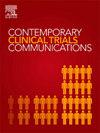Evaluation of the efficacy of Capacitive Resistive Monopolar Radiofrequency at 448 kHz in the physiotherapeutic treatment of female dyspareunia
IF 1.4
Q4 MEDICINE, RESEARCH & EXPERIMENTAL
引用次数: 0
Abstract
Background and purpose
Dyspareunia is genital pain associated with sexual activity that affects the quality of life of many women. Physiotherapy is a promising, albeit sometimes uncomfortable, option. This study aims to integrate capacitive resistive monopolar radiofrequency (CRMRF) as a complementary therapy. This study aims to evaluate the benefits of combining CRMRF with vaginal manual physiotherapy in young women with dyspareunia.
Method
ology: A randomized, prospective, single-blind clinical trial was conducted. Women aged 18 to 30 with superficial dyspareunia were divided into two groups: an intervention group (GI) receiving CRMRF and manual therapy, and a control group (GC) receiving only manual therapy. Four sessions were conducted, assessing sexual function using the Female Sexual Function Index (FSFI) and the Female Sexual Function Questionnaire (FSM). Data were collected before and after treatment, with a follow-up at three months.
Results
Both groups showed significant improvements in sexual function at the end of treatment. In the GI, improvements were observed in desire, arousal, lubrication, satisfaction, and pain reduction. The GC also showed improvements in these domains. No significant improvements were observed in either group at three months, suggesting that treatment benefits were maintained without additional long-term improvements.
Conclusion
Manual therapy alone and in combination with CRMRF improved sexual function immediately after treatment. No additional improvements were observed at three months, indicating the sustained benefits and emphasizing the need to evaluate maintenance strategies and consider psychological factors.
Clinical trials registration
#NCT5844189.
448 kHz电容性电阻单极射频物理治疗女性性交困难的疗效评价。
背景和目的:性交困难是与性活动相关的生殖器疼痛,影响许多女性的生活质量。物理治疗是一种很有前途的选择,尽管有时会让人不舒服。本研究旨在整合电容电阻单极射频(CRMRF)作为补充治疗。本研究旨在评估CRMRF联合阴道手动物理治疗对年轻女性性交困难的益处。方法:采用随机、前瞻性、单盲临床试验。年龄在18 - 30岁的浅表性性交困难女性被分为两组:干预组(GI)接受CRMRF和手工治疗,对照组(GC)只接受手工治疗。通过女性性功能指数(FSFI)和女性性功能问卷(FSM)对性功能进行评估。在治疗前后收集数据,随访3个月。结果:治疗结束时,两组患者性功能均有明显改善。在GI中,在欲望、觉醒、润滑、满意度和疼痛减轻方面观察到改善。GC在这些领域也有所改进。在三个月时,两组均未观察到明显的改善,这表明治疗效果没有额外的长期改善。结论:单纯手工治疗和联合CRMRF治疗后可立即改善性功能。三个月后没有观察到进一步的改善,这表明持续的益处,并强调需要评估维持策略并考虑心理因素。临床试验注册:#NCT5844189。
本文章由计算机程序翻译,如有差异,请以英文原文为准。
求助全文
约1分钟内获得全文
求助全文
来源期刊

Contemporary Clinical Trials Communications
Pharmacology, Toxicology and Pharmaceutics-Pharmacology
CiteScore
2.70
自引率
6.70%
发文量
146
审稿时长
20 weeks
期刊介绍:
Contemporary Clinical Trials Communications is an international peer reviewed open access journal that publishes articles pertaining to all aspects of clinical trials, including, but not limited to, design, conduct, analysis, regulation and ethics. Manuscripts submitted should appeal to a readership drawn from a wide range of disciplines including medicine, life science, pharmaceutical science, biostatistics, epidemiology, computer science, management science, behavioral science, and bioethics. Contemporary Clinical Trials Communications is unique in that it is outside the confines of disease specifications, and it strives to increase the transparency of medical research and reduce publication bias by publishing scientifically valid original research findings irrespective of their perceived importance, significance or impact. Both randomized and non-randomized trials are within the scope of the Journal. Some common topics include trial design rationale and methods, operational methodologies and challenges, and positive and negative trial results. In addition to original research, the Journal also welcomes other types of communications including, but are not limited to, methodology reviews, perspectives and discussions. Through timely dissemination of advances in clinical trials, the goal of Contemporary Clinical Trials Communications is to serve as a platform to enhance the communication and collaboration within the global clinical trials community that ultimately advances this field of research for the benefit of patients.
 求助内容:
求助内容: 应助结果提醒方式:
应助结果提醒方式:


